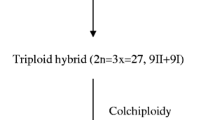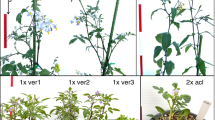Summary
-
1.
Bulbils ofDioscorea of different species and individuals were collected and grown in the garden. Somatic number was found out following Feulgen squash technique.
-
2.
Dioscorea sativa has a chromosome number of 2n=40 andD. alata has a polyploid series of thirty, forty, fifty and seventy chromosomes in different individuals. Satellite counts were also taken.
-
3.
Certain individuals ofD. alata revealed the presence of different chromosome numbers, viz., thirty-eight, fifty-two, fifty-five, sixty-six in the somatic cells of the same individual.
-
4.
Meiotic divisional stages were only obtained inD. saliva showing clear twenty bivalents.
-
5.
Significance of a polyploid series in the same species and different chromosome numbers in the same individual, especially in plants propagating mainly through vegetative means, from the point of view of speciation has been discussed.
Similar content being viewed by others
References
Bhaduri, P. N. 1933. Chromosome numbers of some Solanaceous plants of Bengal.Ind. Bot. Soc. Jour., 12: 56–64.
Blakeslee, A. F. 1941. Effect of induced polyploidy in plants.Biol. Symposia, 4: 183–201.
Chakravorti, A. K. 1951. Origin of cultivated plants of S. E. Asia.Ind. Jour. Genet. Pl. Breed., 11: 34–46.
Clausen, R. E. 1941. Polyploidy inNicotiana.Biol. Symposia, 4: 95–110.
Darlington, C. D. 1937. Recent Advances in Cytology. George Allen & Unwin Ltd., Lond.
Darlington andE. K. Janaki Ammal 1945. Chromosome Atlas of Cultivated Plants. George Allen & Unwin Ltd., Lond.
Emsweller, S. L. andP. Brierly 1940. Colchicine induced tetraploidy inLilium.Jour. Hered., 31: 223–230.
Gunderson, A. 1950. Families of dicotyledons. Chronica Botanica Publications, U.S.A.
Hagerup, O. (1932). Über Polyploidie in Beziehung zu Klima, Ökologie und Phylogenie,Hereditas, 16: 19–40.
Manton, I. 1937. The problem ofBiscutella laevigata, II, Ann. Bot. Lond., N.S. 1: 439–462.
Mookerjea, Archana 1954. Cytogenetics of Aroids.Caryologia, latest issue.
Muntzing, A. 1936. The evolutionary significance of autopolyploidy.Hereditas, 21: 263–378.
Sakamura, T. 1918. Kurze Mitteilung über die Chromosomenzahl und die Verwandtsverhältnisse derTriticum-arten.Bot. Mag. Tokyo, 32: 151–154.
Sharma, A. K. andN. K. Das 1954. Study of karyotypes and their alteration in Aroids.Agronomica Lusitana, 16: 23–38.
Sharma, A. K. andA. K. Bal 1954. A cytological study of few genera of Amaryllidaceae with a view to finding out their phylogeny.Proc. 41st Ind. Sc. Congr. Abstr. (Pt. IV): 25.
Sharma A. K. andN. K. Bhattacharyya 1954. An investigation of the karyotypes of the genusCrinum and its phylogeny.Proc. 41st Ind. Sc. Congr. Abstr.
Sharma, A. K. andChitra Ghosh 1954. Further investigation on the cytology of the family Amaryllidaceae and the bearing on the interpretation of its phylogeny.Genetica Iberica (In press).
Author information
Authors and Affiliations
Rights and permissions
About this article
Cite this article
Sharma, A.K., de Deepesh, N. Polyploidy inDioscorea . Genetica 28, 112–120 (1957). https://doi.org/10.1007/BF01694314
Received:
Issue Date:
DOI: https://doi.org/10.1007/BF01694314




